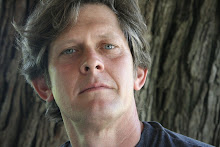
 Meet America’s first green Architect – Frank Lloyd Wright. He called it “organic architecture.”
Meet America’s first green Architect – Frank Lloyd Wright. He called it “organic architecture.”When I was in high school, I came across photos of Fallingwater, the Johnson Wax Building, and the Price Tower. The powerful resonance of those images changed my life.
I remember sitting and staring at those pictures for hours at a time. Intuitively, I knew there was something very magical there, something profound in Mr. Wright’s approach to architecture. Here before me was evidence that the built environment was so much more than floors, walls, and roof.
Fallingwater, nestled into the Pennsylvania countryside and perched on a rock over a waterfall, feels right at home in its dramatic natural environment. Man with nature, not man over nature, is the artistic expression - an extension of nature itself.
In the Johnson Wax Building, lily pad columns artfully structure the main work area manifesting an open environment of space and light. The tower, added later, provides a striking counterpoint to the streamlined linear massing of the original building. Its “tap-root” foundation draws directly from nature for its inspiration.
Especially mesmerizing for me was the plan of the Price Tower – a delightful play of geometries. In the tower floor plan, the square is juxtaposed with a 30-60-120 degree geometry creating an amazing kinetic feel. And in an epiphany for me at the time, I was fascinated with how Mr. Wright consciously augmented the geometry, both horizontally and vertically, when function changed. Each floor in the tower has three square sides of office space; the apartment on the fourth corner is skewed 30 degrees and becomes a two-story space with a bedroom mezzanine looking out over the living space below. The mezzanine takes back the geometry of the rest of the building in geometric sympathy. Beautiful!
I’ve had the wonderful opportunity to spend some time at Taliesin, both in Wisconsin and Arizona as adjunct faculty and (as often as I can) a member of the Taliesin Chorus Mr. Wright started in 1932.
“What did Frank Lloyd Wright mean by organic architecture?” is a question I have posed to many senior apprentices who studied under the master before his death in 1959. Not surprisingly, I get a different answer every time I ask the question.
“The whole is to the part as the part is to the whole.”
“Each building must respond to Nature, and every building must have its own Nature.”
(Mr. Wright always put a capital N on Nature.)
“Emulate, never imitate.”
And the explanations go on and on like the beautiful poetic tapestry that is organic architecture. Like Nature, Mr. Wright breathed LIFE and SPIRIT into everything he touched. Isn’t that the essence of green architecture?
Today, the Frank Lloyd Wright Foundation carries on the legacy. Plan a tour of Taliesin East or Taliesin West, and donate to the organization by going to their website:
http://www.franklloydwright.org/
And check out what is going on at the Frank Lloyd Wright School of Architecture on their website:
http://www.taliesin.edu/
I will be spending a week, probably around his birthday (June 8th), on different aspects Frank Lloyd Wright’s work and his contribution to American architecture.





3 comments:
That house is incredible!
Yes PR, When it comes to Falling Water, I can't find a superlative too "over the top." It is the building - along with the Price Tower and the Johnson Wax tower - that inspired me to become an architect. Photos are great, but in person: Magnificent!
And GV, if viagra became an inexpensive, readily available, over the counter item in the US, do you think we would see more organic architecture?
Post a Comment